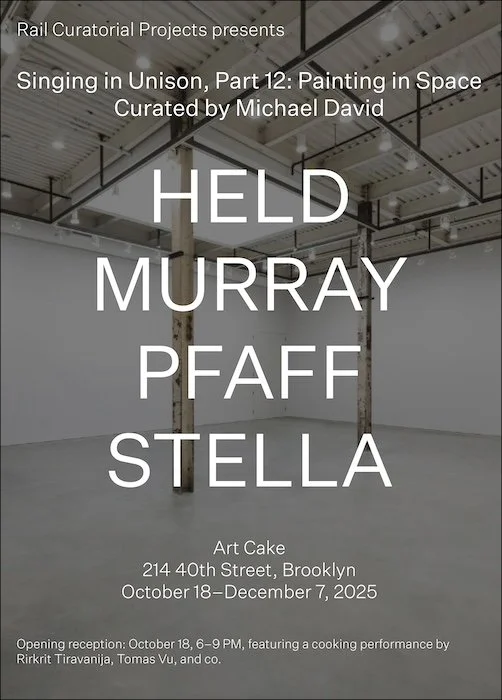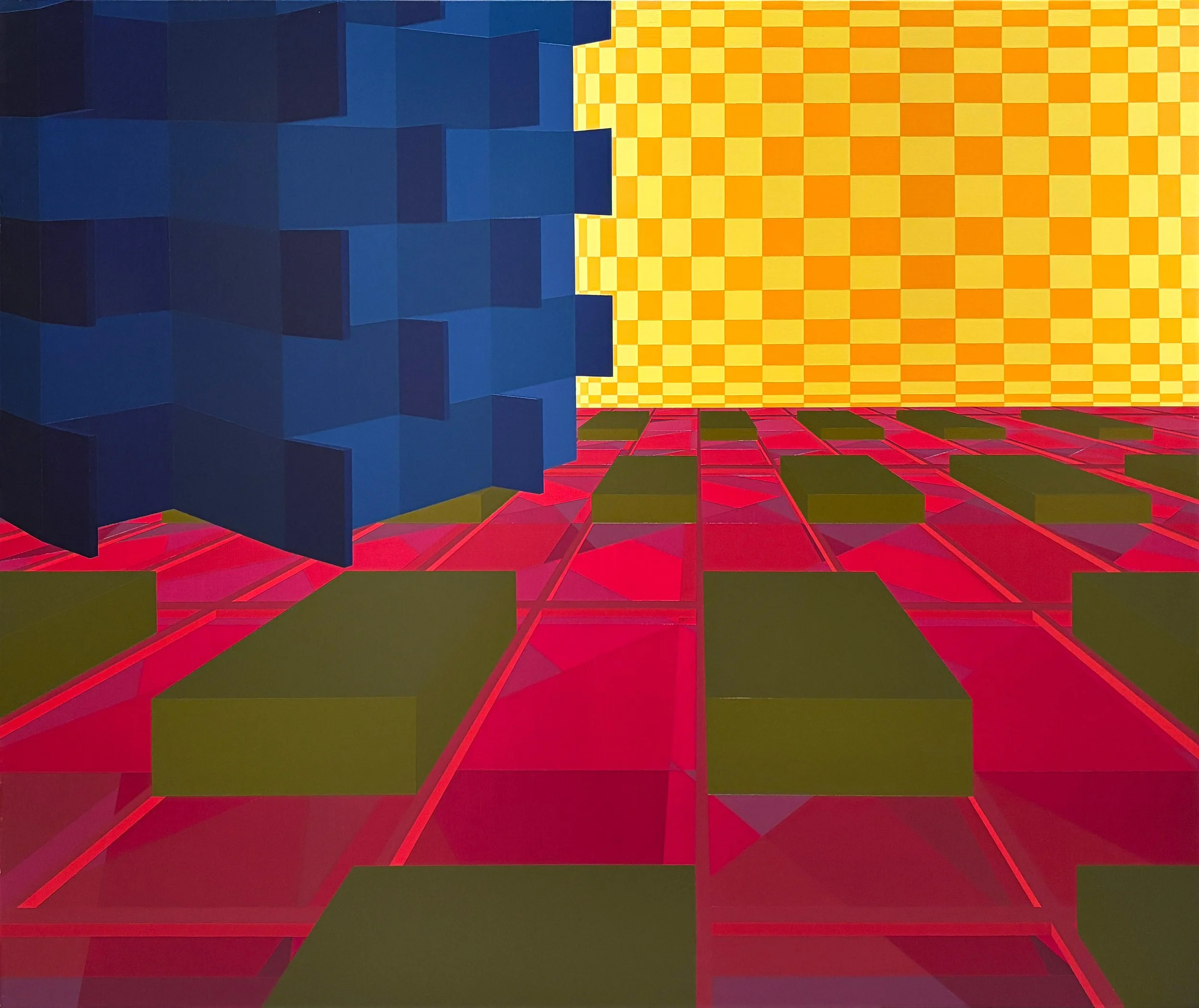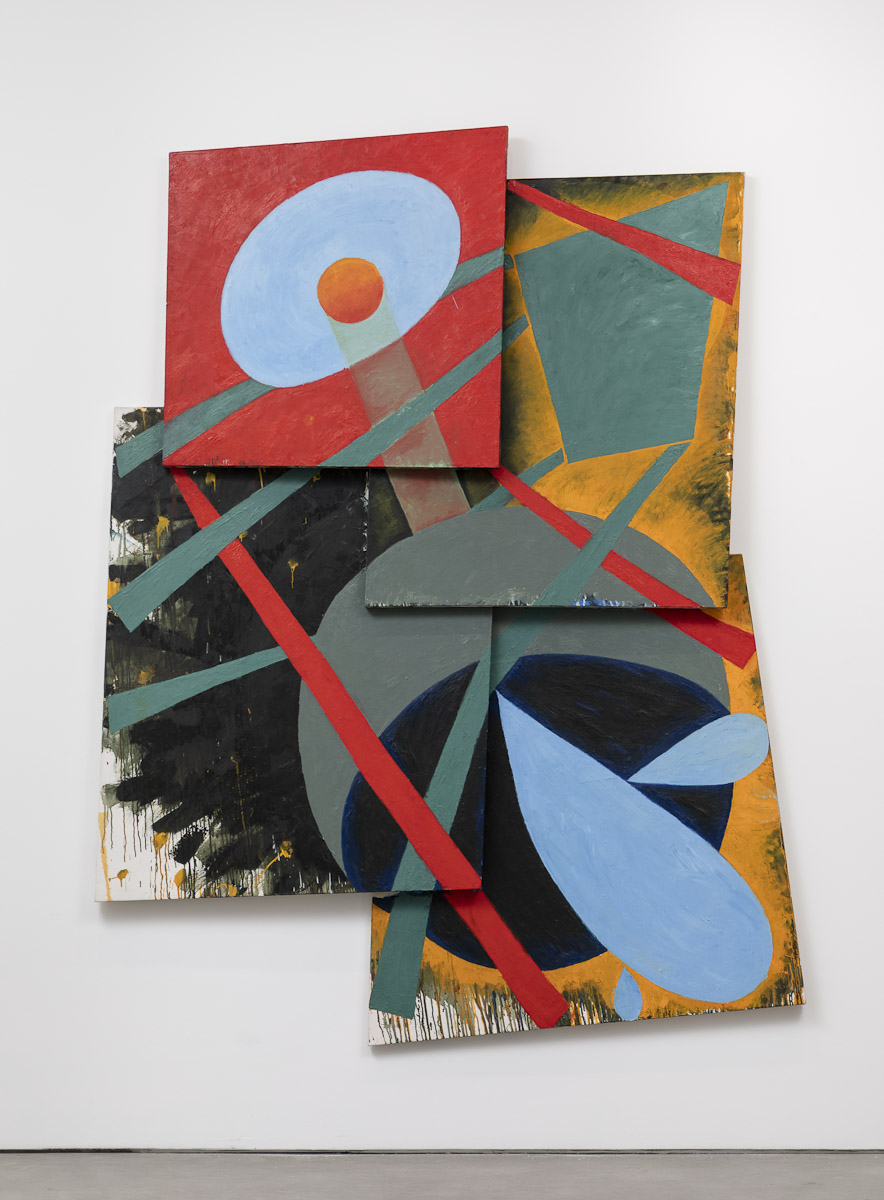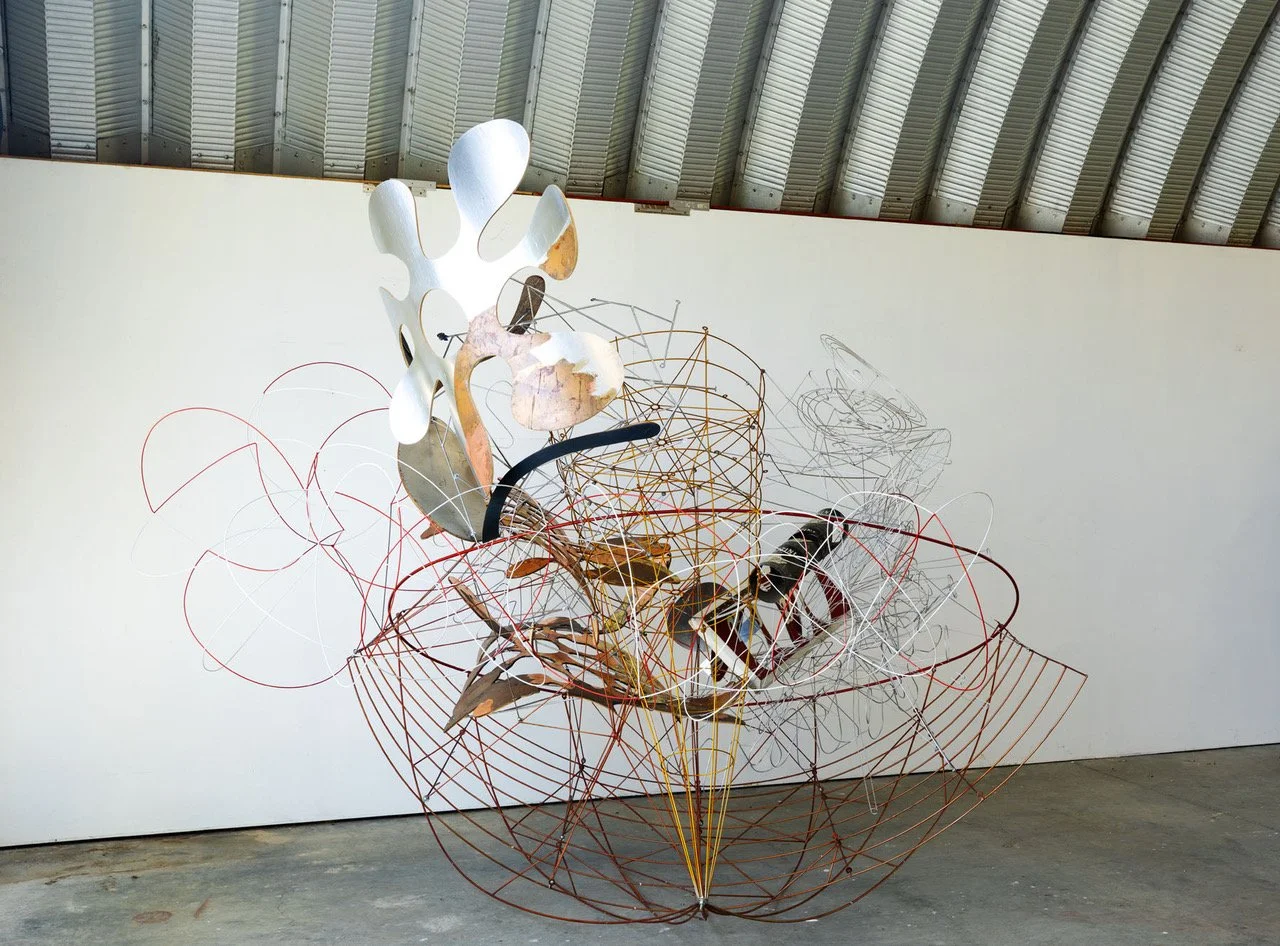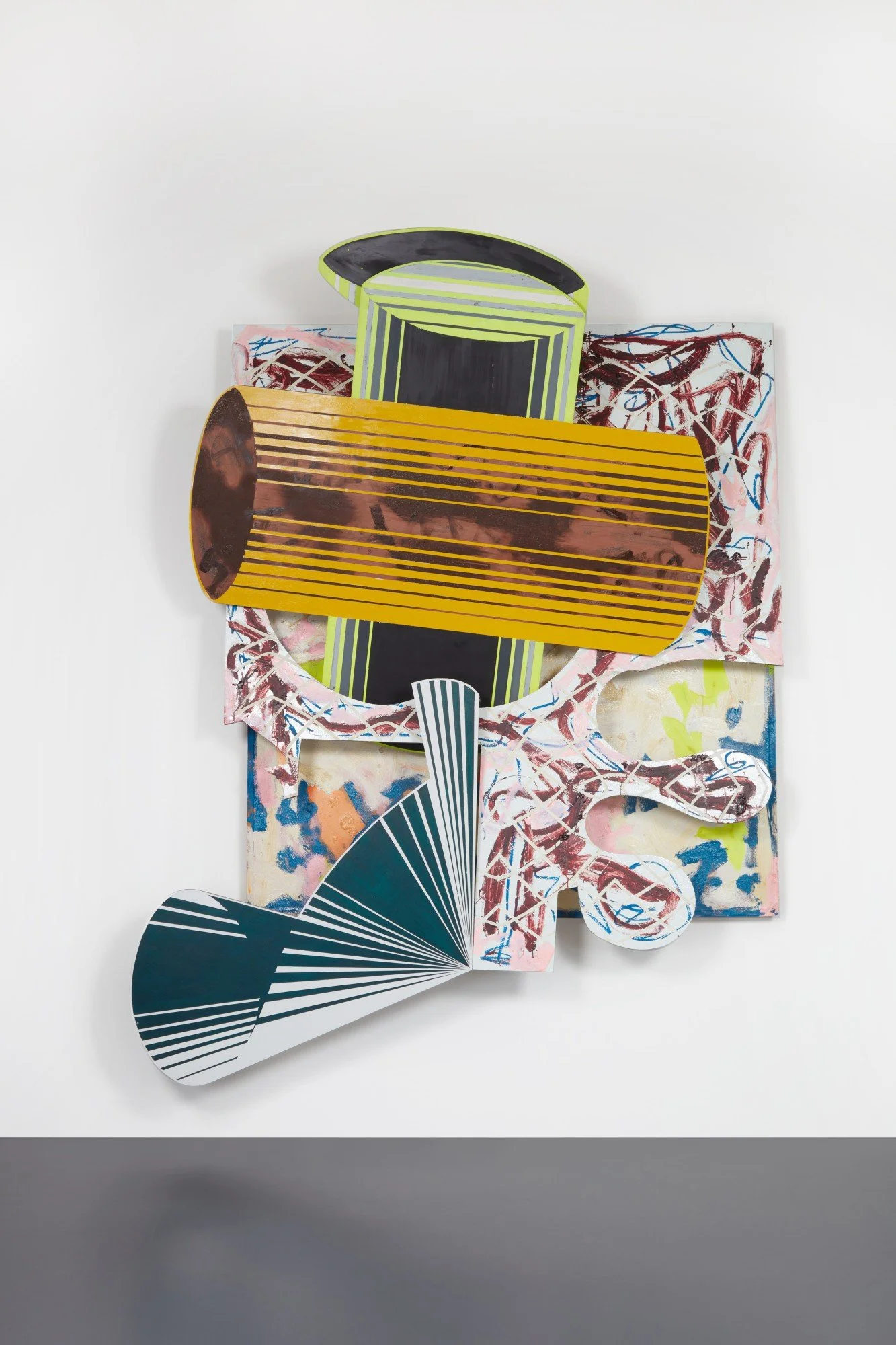Singing In Unison, Part 12: Painting In Space:
Al Held, Elizabeth Murray, Judy Pfaff, and Frank Stella
Curated by Michael David
Presented by M. David & Co. at Art Cake
October 18 - December 7, 2025
Artist Talk: Saturday, November 8th at 4PM
M. David & Co. is pleased to present Singing In Unison, Part 12: Painting In Space, curated by Michael David in cooperation with the Brooklyn Rail's ongoing series, Singing in Unison. This group exhibition features works by Al Held, Elizabeth Murray, Judy Pfaff, and Frank Stella.
Review in Hyperallergic by John Yau
Review in Art Spiel by Etty Yaniv
Video by Gabriel Gavidia
Three years ago, after a few glasses of wine at dinner, a conversation with Judy Pfaff turned to her close friend and early champion, Al Held. From there, it drifted to another dear friend, Elizabeth Murray, and then to her admiration for Frank Stella.
These four—some closer to each other than the rest —were not “singing in unison” at that particular moment in time. Yet they all shared a profound respect for one another’s work, and deep, if sometimes unacknowledged, influences.
What united them was the language of geometry, made personal. Their rigor of formal concerns was always present, but each bent geometry to their own ends, carving out space for themselves. Elizabeth, Frank, and Judy literally challenged the rectangle, how far a painting could come off the wall, what it could be made of (a language that Stella had pioneered earlier) and the very definition of what a painting could be. Al, through his unprecedented use of scale, celebrated the intensity of the object and created deep pictorial space, echoing the grandeur of the Italian Renaissance while flirting with a kind of sci-fi vision -- imagery that, in retrospect, seems to anticipate contemporary technologies like AI, yet always remaining rooted in the human touch, through endless sanding and reworking of his works.
Almost half a century later, all these four artists' innovations, which have inspired generations of artists, still feel as revolutionary as the day they were created.
When Phong Bui invited me to curate Painting in Space as part of The Brooklyn Rail’s Singing in Unison series, with Cal McKeever’s tireless support, along with Cordy and Ethan Ryman generously providing their Kunsthalle-like space at Art Cake, this dream of mine that began with a glass of wine years ago has finally become reality.
As this exhibition was inspired by my conversation with Judy about all of these artists a few years back, it seems fitting to close with a special quote of hers from the memorial for Al Held, which was published in The Brooklyn Rail twenty years ago almost to the day. Her words speak not just to Al, but to all the artists in this exhibition, and importantly, to all who seek to create space for themselves - not only pictorial, but beyond - inspiring each of us with the gift of possibility.
“Space for Al was the only frontier; it offered infinite possibilities and wonder. His paintings are difficult, demanding, protean, and incredibly beautiful. I think in the last few years his paintings became optimistic, gathering in both the expanding language of painting and science. The last few years he was spending more time in Italy, in his home in Camarata. There he was free, alone in the studio, surrounded by art history and warm light, and the world of ideas. Al Held is a great artist. I miss him. I am still his student.” —Judy Pfaff
So, for the first time, Al, Elizabeth, Frank, and Judy are exhibiting together, honoring this moment when the language of painting is redefined once more. They are now truly Singing in Unison.
Michael David
Painter, Curator
Artist Biographies:
Al Held, Three and Three Quarters, 1996, Acrylic on canvas, 60 x 72 inches
Al Held (1928–2005), a pioneer of hard-edged abstraction, created works of great complexity that acknowledged the then-dominant painterly vocabulary of American abstraction at the same time as being profoundly informed by a history of painting rooted in the European Renaissance.
During his 50-year career, Held single-mindedly committed to an exploration of the potential for abstraction to reach beyond the realm of the viewer’s primary senses.
Continually expanding his painterly language and practice, often in opposition to the dominant ideologies, as the painter and his former student Michael Craig-Martin wrote: ‘His work remained rigorous, and uncompromising, challenging one’s perceptual pre-conceptions and intelligence, rather than conforming to received wisdom or flattering good taste.’
Elizabeth Murray, Flying Bye, 1982, Oil on canvas, 104 x 80 x 9 inches
Elizabeth Murray (b. 1940, Chicago, Illinois) and took an early interest in making and studying art. While attending the School of the Art Institute of Chicago, she was deeply influenced by the work of Paul Cézanne, which inspired her to pursue a degree in painting. Following her education, Murray moved to New York, where she developed a unique approach to art-making and honed her intuitive ability to masterfully combine shapes and colors in both two- and three-dimensional realms.
Her work has been the subject of numerous institutional exhibitions, including the Carnegie Museum of Art, Pittsburgh; Contemporary Arts Museum, Houston; University at Buffalo Art Galleries, New York; The Museum of Modern Art, New York; the Dallas Museum of Art; the Albert and Vera List Visual Arts Center, MIT, Cambridge, Massachusetts; Museum of Fine Arts, Boston; The Museum of Contemporary Art, Los Angeles; Des Moines Art Center, South Dakota; Walker Art Center, Minneapolis; and the Whitney Museum of American Art, New York. Her work is included in public collections worldwide, including Art Institute of Chicago; Brooklyn Museum, New York; Hirshhorn Museum and Sculpture Garden, Smithsonian Institution, Washington, D.C.; Los Angeles County Museum of Art, California; The Metropolitan Museum of Art, New York; The Morgan Library & Museum, New York; The Museum of Contemporary Art, Los Angeles; Museum of Contemporary Art, Tokyo; Museum of Fine Arts, Boston, Massachusetts; Museum of Fine Arts, Houston; The Museum of Modern Art, New York; National Gallery of Art, Washington, D.C.; Philadelphia Museum of Art; Solomon R. Guggenheim Museum, New York; Walker Art Center, Minneapolis; Whitney Museum of American Art, New York; and Yale University Art Gallery, New Haven, Connecticut. The Elizabeth Murray Estate is run by Elizabeth’s daughter Daisy Holman.
Judy Pfaff, Buttercup, 1991, Lacquered steel, silver and copper-leafed wiggle board, found objects, signage, Dimensions variable
Judy Pfaff (b. 1946, London, UK) received a BFA from Washington University Saint Louis (1971), and an MFA from Yale University (1973) where she studied with Al Held. Her work spans across disciplines from painting to printmaking to sculpture to installation, but is perhaps best described as painting in space. These spatial paintings inhabit and transform their environments, becoming ad hoc homes for viewers and the artist.
Drawing upon a wealth of spiritual, botanical, and art historical imagery, Pfaff’s installations simultaneously and without contradiction reference the austerity of a cathedral and the temporality of a mandala. Like a mandala, the life of Pfaff’s work is brief and burning, deconstructed and sections discarded after a show comes down. Each installation considers the specific spatial geometries of the room, the ceiling, the street out the window, so that no two shows are ever alike. This tenacious generosity Pfaff offers her viewers, in which she and her crew labor for months or years for shows that last days or weeks, sets Pfaff apart from colleagues in other disciplines who can rely on sales of discrete objects. Refusing to give narrative meaning to her work, this urgent and ferocious need to labor for the visual and tactile is remarkable in an era where language dominates artistic activity.
She exhibited work in the Whitney Biennials of 1975, 1981, and 1987, and represented the United States in the 1998 Sao Paulo Bienal. Her pieces reside in the permanent collections of MOMA, Whitney Museum of Art, Tate Gallery, Brooklyn Museum of Art, and Detroit Institute of Arts, among others. She is the recipient of many awards including the Lifetime Achievement Award from the International Sculpture Center (2014), the MacArthur Foundation Award (2004), and the Guggenhiem Fellowship (1983). Pfaff lives and works in Tivoli, New York.
Frank Stella, Il Palazzo delle Scimmie 4x, 1984, Acrylic and enamel on aluminum, 136 x 106 x 17 inches, Courtesy of the Estate of Frank Stella / © 2025 The Estate of Frank Stella / Artists Rights Society (ARS), New York
Frank Stella (1936 - 2024) studied art at the Phillips Academy, Andover. He continued his study at Princeton University. After graduating he moved to New York City, where he supported himself by painting houses.
When Stella entered the art scene, many young American artists were struggling with the legacy of abstract expressionism, which had set the standard for avant-garde art since the late 1940s. Jackson Pollock, Franz Kline, Willem de Kooning, and others had established a visual vocabulary of abstract, energetic self-expression. Although he was attracted at first by the physicality of abstract expressionism, Stella was searching for a new way to approach the canvas. The repetition, flatness, and unemotional restraint of Jasper Johns' flag and target paintings provided inspiration.
Stella's explorations began with his series of black "pin-stripe" paintings, which created a furor in the New York art world in 1959. That year, at age twenty-three, he was the youngest artist included in the Museum of Modern Art's exhibition Sixteen Americans. Stella's method of working systematically in a series emphasized his problem-solving approach to painting. He arranged flat color fields into repetitive, geometric patterns and created all-over, non-illusionistic surfaces. His logic, control, and extreme reductionism prefigured minimalism.
Stella continued working in an austere style through the early 1960s, but gradually his canvases assumed curvilinear shapes and a bright palette. In the 1970s he moved from works on flat surfaces to compositions which projected out from the wall. First Stella made collages, then shallow reliefs, and finally fully spatial constructions like the Circuit series. The complex shapes and the colorful, painterly marks of more recent work refer to the gestural abstract art of the 1950s. While the scale and size of Stella's works have become grander, the process has become more spontaneous. The artist continues to push the relationship of figure and ground to the point of minimizing the ground. The result is sculptural.

